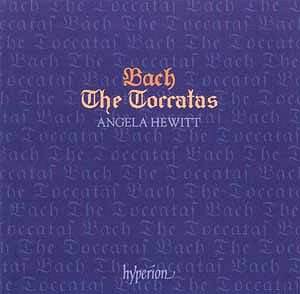Angela Hewitt approaches Bach’s toccatas, adding
another brick to the edifice of her recording of his complete
works for keyboard. Bach’s toccatas are among the most improvisatory
of his keyboard works; written in stylus fantasticus, which,
as Hewitt says in her notes, is "a very unrestrained and
free way of composing, using dramatic and extravagant rhetorical
gestures" combines "improvisatory passages … with stricter,
more imitative sections." This style of composition can be
heard in many of Bach’s preludes, but the difference in the toccatas
is the combination of several different sections into a single
work.
Hewitt’s recording is probably the freest of
all her Bach recordings. She lets her heart rule the tempi, and
seems much less strict than in some of her other discs. This is
naturally the result of the toccata form, but she fits this music
almost perfectly. Unfortunately, of all of Bach’s keyboard works,
the toccatas are perhaps the least suited for the piano, or, at
least, for the way pianists attempt to play them. Her dynamics
sometimes conflict with the music - listen to the second section
of the G major toccata, where she varies soft and loud playing
in a sort of echo. The result sounds somewhat artificial, as do
some other piano sections. But in the more lively fugal
sections, Hewitt comes into the zone. The first fugue of the F
sharp minor toccata comes alive with her staccato playing, and
other fugues are also full of energy. The first fugue in the D
minor toccata is also brilliant; Hewitt excels at playing fugues
- one can certainly hope that she records Bach’s Art of Fugue
one day…
But this recording is probably the least "Bachian"
of all her Bach discs. She plays these works, at times, as if
they were written two hundred years later, infusing them with
a variety of feelings and tones that seem more appropriate to
romantic piano music. Her unbridled opening section of the D minor
toccata is one example of this, where she seems to be playing
Liszt, not Bach. Yet this is not a drawback - Angela Hewitt is
giving new energy to these works, and her recording certainly
stands as one of the best on piano.
(A few notes about the recording - there is a
great deal of reverberation on this disc, which, at times, is
annoying and sounds artificial, especially when listening with
headphones. There is also a very jarring moment at the end of
the F sharp minor toccata, when Hewitt holds the final chord for
only a brief moment, cutting of what should be natural sustain
as the chord fades out.)
Another excellent recording by Angela Hewitt,
who shows her mastery of Bach’s keyboard music, and especially
gives a unique insight into what are some of his freest keyboard
works.
Kirk McElhearn
